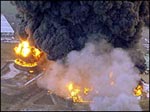 |
|
Fundamental Safety Management Flaws Lay Behind Buncefield Disaster
 Fundamental safety management failings were the root cause of Britain's most costly industrial disaster, a new publication reveals. Fundamental safety management failings were the root cause of Britain's most costly industrial disaster, a new publication reveals.
The report into the explosion and five-day fire at the Buncefield Oil Storage Depot in December 2005 tells for the first time the full story of the Health and Safety Executive (HSE) and Environment Agency's (EA) investigation.
Drawing on previously unpublished material held back until the criminal prosecution was completed and the appeals processes exhausted, The Buncefield explosion: Why did it happen? identifies several failings including:
- Systems for managing the filling of industrial tanks of petrol were both deficient and not fully implemented
- An increase in the volume of fuel passing through the site put unsustainable pressure on those responsible for managing its receipt and storage, a task they lacked information about and struggled to monitor. The pressure was made worse by a lack of necessary engineering support and other expertise.
- A culture developed where keeping operations going was more important than safe processes, which did not get the attention, resources or priority status they required.
- Inadequate arrangements for containment of fuel and fire-water to protect the environment.
Gordon MacDonald, the chairman of the COMAH Competent Authority Strategic Management Group which published the report, said:
"Major industrial incidents are thankfully rare - this report will help make them even less frequent by sharing some key insights and lessons with the wider high hazard industries. Companies that work in a high hazardous industry need to have strong safety systems in place, underpinned by the right safety culture. Buncefield is a stark reminder of the potential result of a poor attitude towards safety. The local community was devastated and the environmental impact of the disaster is still evident today. With estimated total costs exceeding £1billion, this remains Britain's most costly industrial disaster."
In July 2010, five companies were fined a total of £9.5million for their part in the catastrophe.
The 36-page report highlights a number of process safety management principles, the importance of which were underlined by the failings at Buncefield:
- There should be a clear understanding of major accident risks and the safety critical equipment and systems designed to control them.
- There should be systems and a culture in place to detect signals of failure in safety critical equipment and to respond to them quickly and effectively.
- Time and resources for process safety should be made available.
- Once all the above are in place, there should be effective auditing systems in place which test the quality of management systems and ensure that these systems are actually being used on the ground.
At the core of managing a major hazard business should be clear and positive process safety leadership with board-level involvement and competence to ensure that major hazard risks are being properly managed.
Source: HSE
|
|
|
Designed, Hosted and Maintained by Union Safety Services
|